What Is A Good Registered User Conversion Rate For Consumer App
E-commerce conversion rate and lead generation landing page stats for desktop and mobile devices for benchmarking averages across different industries
As you will know, conversion rates are often used as a KPI to review the effectiveness of e-commerce sites. Naturally, all site managers and owners want to know the benchmarks - "how do our conversion rates compare?". Now, as marketers plan for 2022, it's never been more important to audit and optimize your marketing success metrics.
In this post, I have compiled different free industry sources focusing on retail e-commerce conversion. At the end of this article, we also feature an analysis of landing page lead generation conversion rates by industry sector towards the end of the post. We keep this compilation updated as new conversion data is published in 2022.
How are e-commerce conversion rates measured?
When benchmarking conversion, it's important to consider the denominator. Are you dividing the number of sales by the number of unique visitors or visitor sessions?
In Google Analytics, which can be considered the standard reference, sales transactions are divided by visits. E-commerce Conversion Rate is defined by Google as:
"The ratio of transactions to sessions, expressed as a percentage. For example, a ratio of one transaction to every ten sessions would be expressed as an Ecommerce Conversion Rate of 10%".
Before we get to the stats, a couple of caveats on benchmarking conversion rates:
When benchmarking conversion rate, we think it's important to explain to marketing managers that they should go beyond headline conversion rates to segment conversion by different types of visitor.
To see why, take a look at Dan Barker's excellent post explaining why conversion rate is a horrible measure to focus on...
Retail conversion rates by region
If your marketing strategy includes geo-targeting, can be particularly useful to come up with country-specific KPIs for segments of your customer base. The key here is for these stats to inform your goals not to define them.
The Kibo e-commerce Quarterly is a great source giving regularly updated benchmarks on conversion in the US, GB, and EMEA, segmented by devices and media for large e-commerce brands.
The latest data was published by Kibo is from Q2 2021. The full report also includes average add-to-basket rates.


It's also useful to include cart and abandoned cart rates here to get a fuller picture of the funnel.


Optimize a data-driven approach to your e-commerce marketing strategy so you can plan and manage your marketing activities informed by the latest stats and best-practice. Quickly convert more customers with our tried and tested system. Find out more
E-commerce conversion benchmarks by industry
Many marketers set their KPIs based on industry benchmarks. For example, if you're catering to a market with a lower overall conversion rate, a good conversion rate may still be lower than the average across all industries.
Unbounce's 2021 Conversion Benchmark Report compared landing page conversion rates across 16 industries - with 'catering & restaurants coming up top with an average conversion rate of 9.8%. Agencies and real estate represent the other end of the scale, converting only 2.4% and 2.6% respectively.
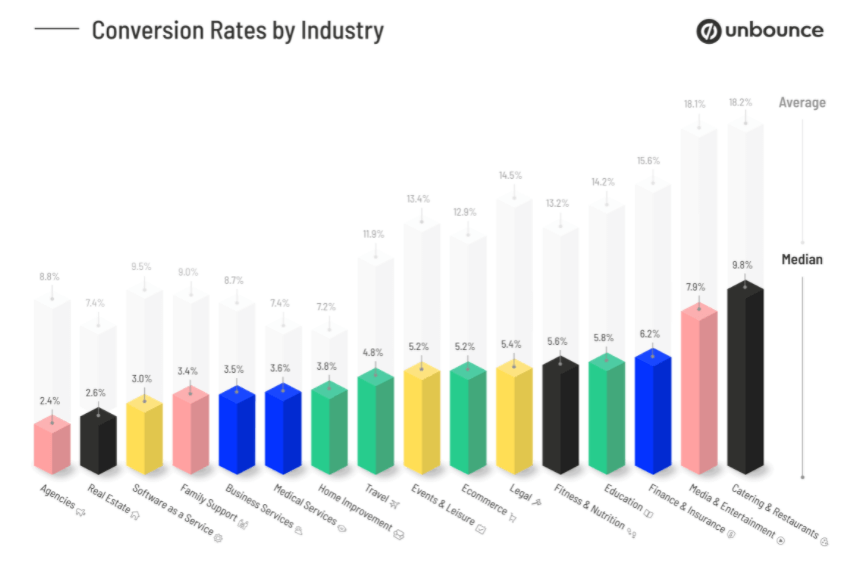
Meanwhile, online shopping data from April 2021 data puts food & beverage as the top online shopping category for conversion rate in the first quarter of 2021. The next highest converting categories of 2021 were hair care, beauty and skincare, and health and beauty. Luxury items and homeware (home furniture/ appliances) seemed to convert at a much lower level in 2021.
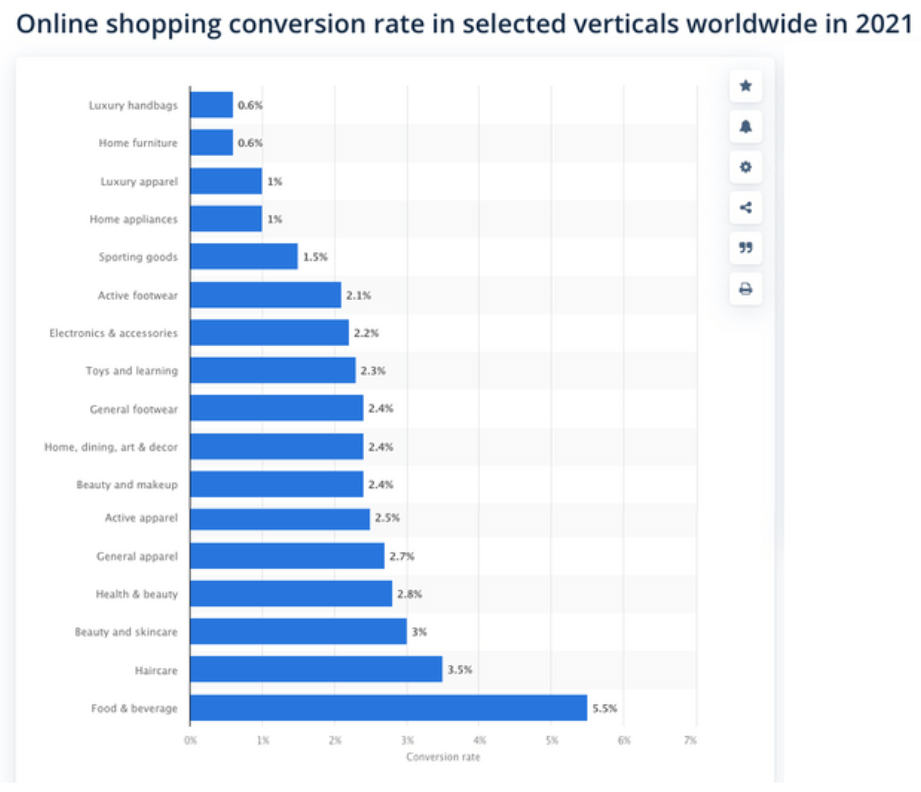
Keep up to date with the latest e-commerce stats and trends to reach and convert more customers on your digital platforms. We have tools and training to support a data-driven approach to your e-commerce marketing strategy in 2022.
Mobile e-commerce conversion rates
With shoppers increasingly using smartphone and tablet to purchase, it's vital for online retailers to know which conversion benchmarks they should be achieving on a smartphone device. Globally, the average order value on a desktop was 42% higher than on a mobile phone in Q3 2020.
We recommend our advanced module mobile and multiscreen usability for marketers looking to improve their customers' multichannel e-commerce digital experiences.
Further insight is available on conversion rates by operating system:
This shows that iOS conversions are slightly higher than Android, and Windows conversions are significantly higher than Mac. It's unclear to what extent this is based on usability against other demographics.
Omnichannel conversion rates
Compilations of published conversion rates often only consider online conversion to sale. Research by Google and Wolfgang Digital shines a light on 'research-online purchase-in-store'.
"By uploading Point Of Sale information to Google, retailers can now match in-store purchasers with online ad clickers, gaining further visibility on the success of their campaigns."
The results speak for themselves: digital marketers saw an extra 168% in revenue in their in-store sales, on top of what was made online.

What are the reasons consumers are less likely to buy on smartphones?
The comScore Mobile Hierarchy report has some useful insight into this, which retailers can use to improve their service or messaging to reassure consumers.
E-commerce conversion rates by country
It can be particularly useful to come up with country-specific KPIs for segments of your customer base. It might also be necessary to amend KPIs based on industry benchmarks if you're catering to a market with a lower overall conversion rate. As always, the key here is for these stats to inform your goals not to define them.
In the table below, Germany leads with an average conversion rate of 2.22% while Italy lags behind at 0.99%.
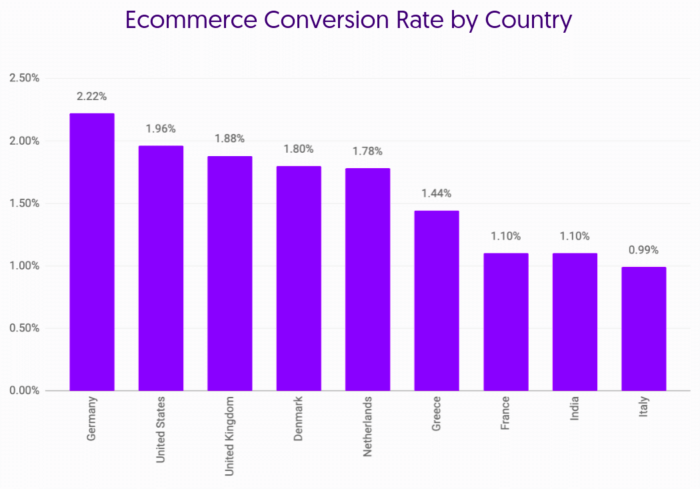
Looking for new marketing solutions to win more customers? We have tools and training to support a data-driven approach to your 2022 e-commerce marketing strategy for YOY growth.
Google Ads mobile conversion rates across different industry sectors
The 2021 cross-industry Google Ads clickthrough rate and conversion benchmarks show that:
The average conversion rate in Google Ads on mobile across all industries is 3.48% on the search network and 0.72% on the display network.
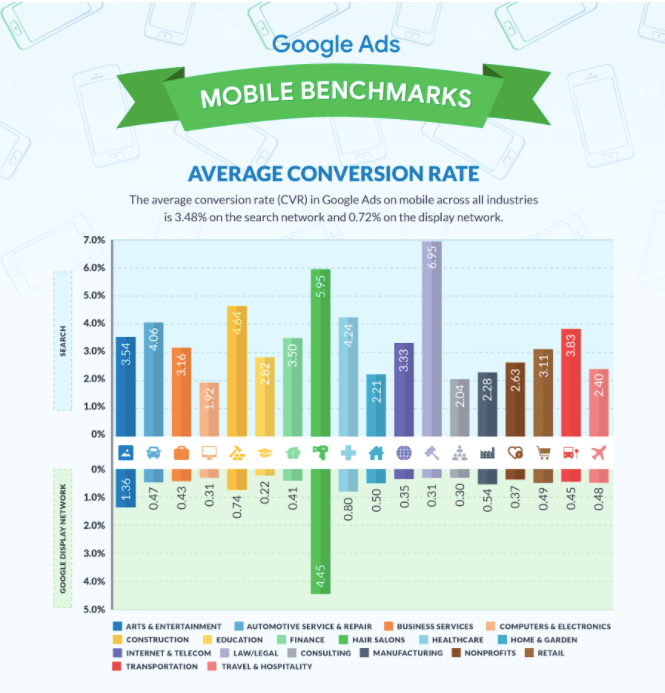
It's no surprise that the conversion rate in the search network is much higher than in the display network since, in the search network, searchers are typing in product and brand names when they have a specific intent. This isn't the case in the display network where they are responding to banner and text ads, typically on publisher sites.
The results from 18 industries could be useful if you are a startup modeling conversion rates as part of a business plan, or if you want a top-level comparison for your activities with others in your industry.
Of course, the outcome that is measured as conversion rate will vary according to the sector and depending on the type of keyword. Brand searches always have higher clickthrough and conversion rates than generic searches, for example. For retail, the outcome will be conversion to sale, but in many other sectors show, the conversion will be converted to lead.
E-commerce conversion funnel
This funnel-based view of the conversion process is useful since as well as the average basket and sales conversion rates, it also shows the conversion rates to product page views which aren't published so often:
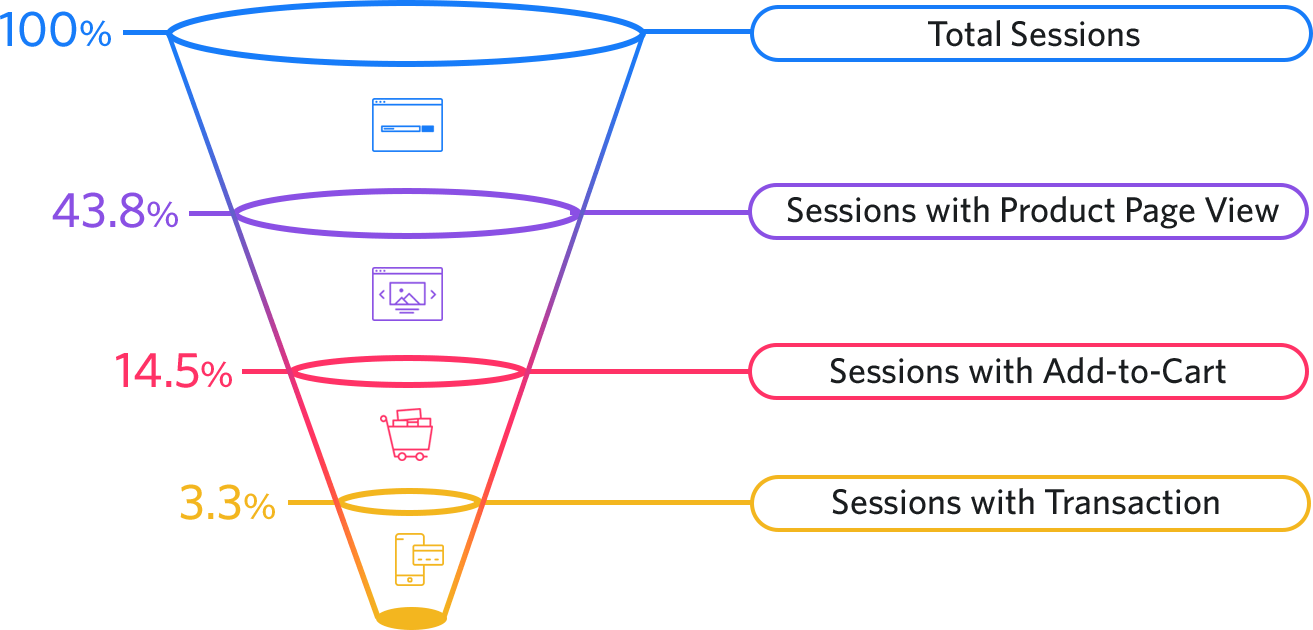
As would be expected, the number of sessions with product page views is much higher than the other micro-conversions, approaching 50 percent. This provides a useful benchmark and prompts retailers that it's useful to assess conversion to product page views when making site design improvements.
It also reminds us of the value of following up on interest in specific products and categories via sending personalized automated browse abandon emails. We have dedicated tools and training to support marketers using automation to optimize their marketing strategy.
Conversion by channel
This research from Optimizely Episerver retail clients Q1 2020 (based on 1.3 billion unique shopping sessions across 159 unique retail and consumer brand websites) shows a typical pattern. Conversion rates are significantly higher where consumers have higher intent, i.e. they are searching for products. This compares to social and display referred visits where conversion rates are significantly lower.
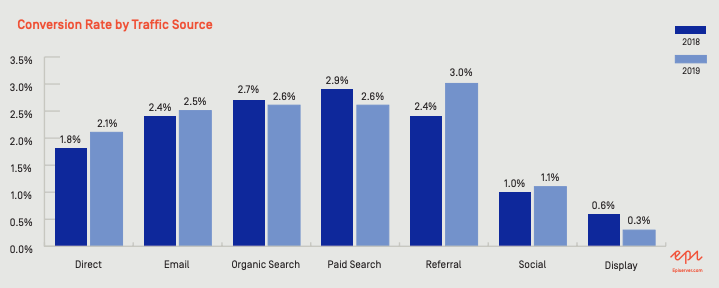
Options for segmenting e-commerce conversion rates
As Dan Barker suggests in his advice we mentioned at the start of this post, conversion rate gets more useful as you break it down by different types of visitors with different intent and a different relationship with the retailer.
Different conversion rates and average order values can then be segmented for different audiences to understand and work to improve the quality of traffic or strength of propositions, for example:
- First time, repeat visitor or registered customer conversion
- Referring channel conversion, e.g. paid or natural search, social media, affiliates, display advertising
- Search type, e.g. paid or natural, brand, generic or long-tail
- Product category type - conversion rates are much higher for simple commodity products for example - flower purchase (double-digit percentage) compared with a higher cost product that will often be purchased in-store (for example beds or furniture which will often be less than one percent).
- Promotion type or seasonal sale - the IMRG data and Coremetrics data below shows that conversion rates can increase dramatically at these times.
Keep up to date with the latest digital marketing stats and trends to reach and convert more customers on your e-commerce website. Identify new opportunities to develop your digital strategy and win more customers with our dedicated guidance and support for retailers.
Lead generation and landing page conversion rates by sector
This 2017 landing page lead generation conversion rate research from Unbounce reports lead conversion rates by industry. Industries covered include business-to-business, Travel, Healthcare, Legal and Education sectors.
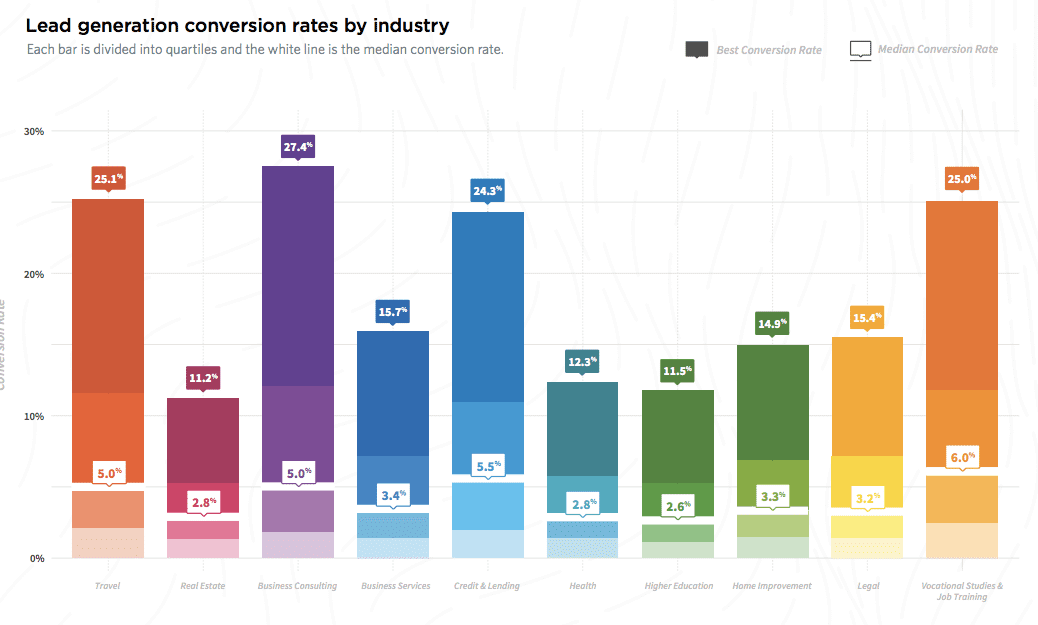 The chart shows wide variation within and between sectors with some businesses achieving lead generation conversion rates much higher than the media. So, to compare against your rates it's best to look at the media rates which vary between 2.8% and 6%.
The chart shows wide variation within and between sectors with some businesses achieving lead generation conversion rates much higher than the media. So, to compare against your rates it's best to look at the media rates which vary between 2.8% and 6%.
We have retained this older version since it shows the range of conversion rates. In 2020 Unbounce released a new landing page conversion rate compilation.
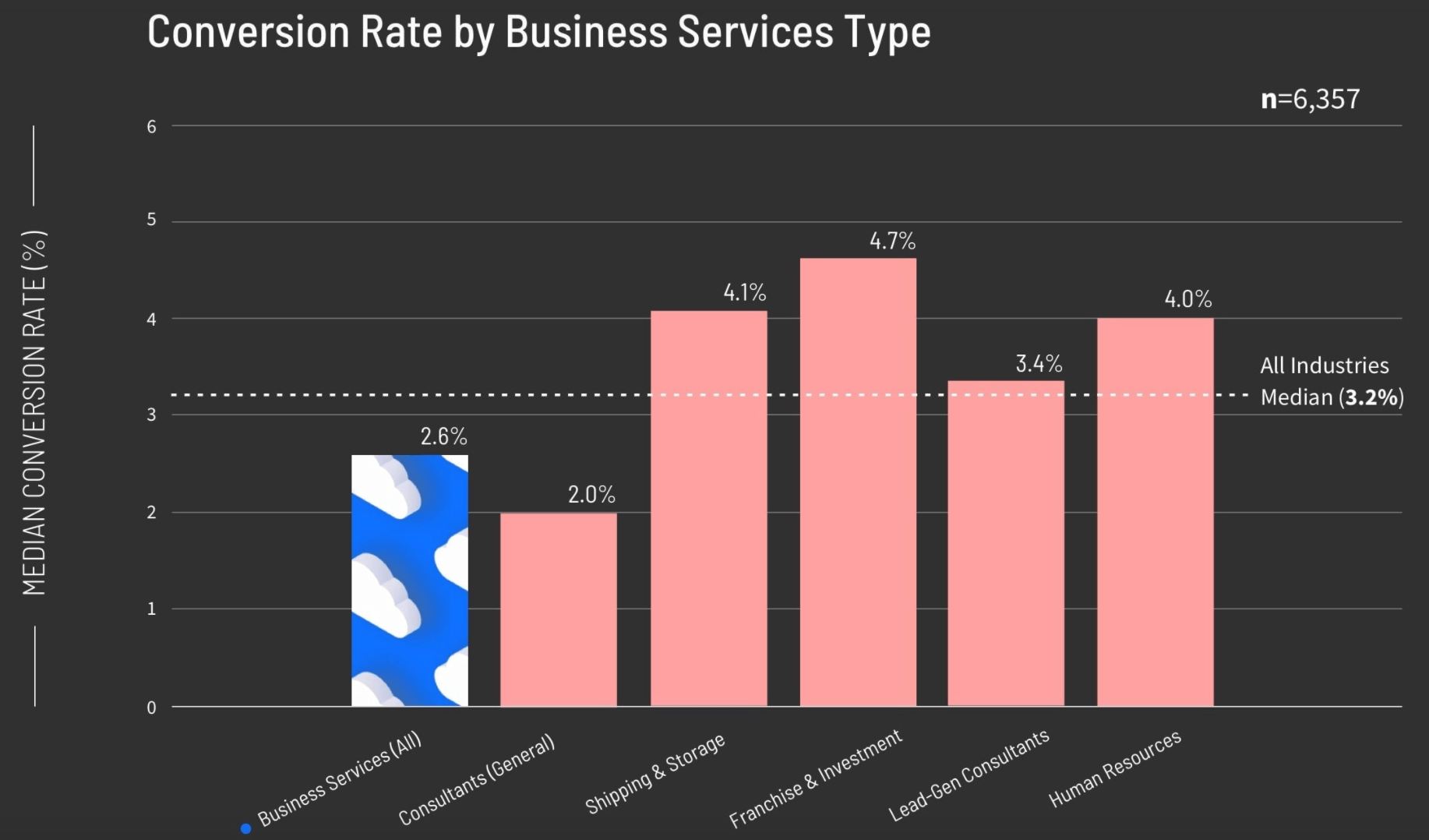
Form completion conversion rate comparison
Another source to use for benchmarking lead generation efficiency which has unique insight breaking down the process by sector is provided by the Zuko form performance benchmarks October 2021.
Form types include purchase, inquiry, and registration data. Most forms tracked are transactional forms of various kinds, but you can see the full breakdown below.
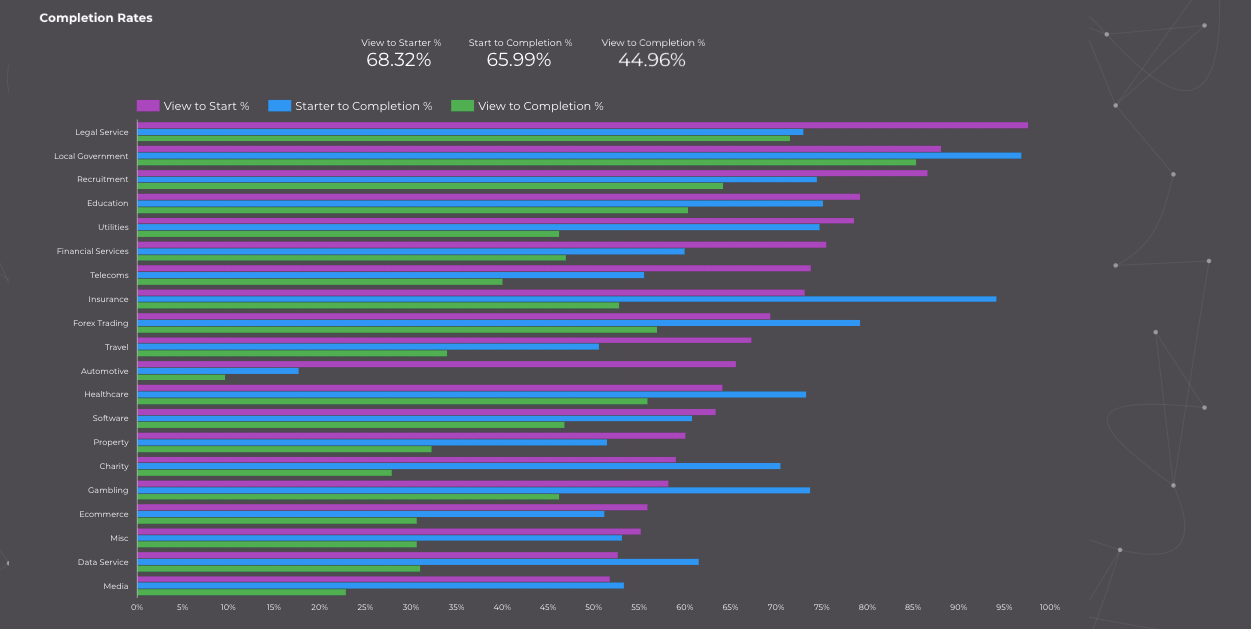
This shows that typically only one-third of people start entering data into the form, showing the value in AB testing to ensure you make the value of completing the form via the title, copy, imagery and follow-up clear. Overall, just under half typically complete each form.
Want to find out more? Keep up to date with the latest e-commerce stats and trends to reach and convert more customers on your digital platforms. We have tools and training to support a data-driven approach to improve your e-commerce conversion rates. Start now.
What Is A Good Registered User Conversion Rate For Consumer App
Source: https://www.smartinsights.com/ecommerce/ecommerce-analytics/ecommerce-conversion-rates/
Posted by: hansenmirere.blogspot.com

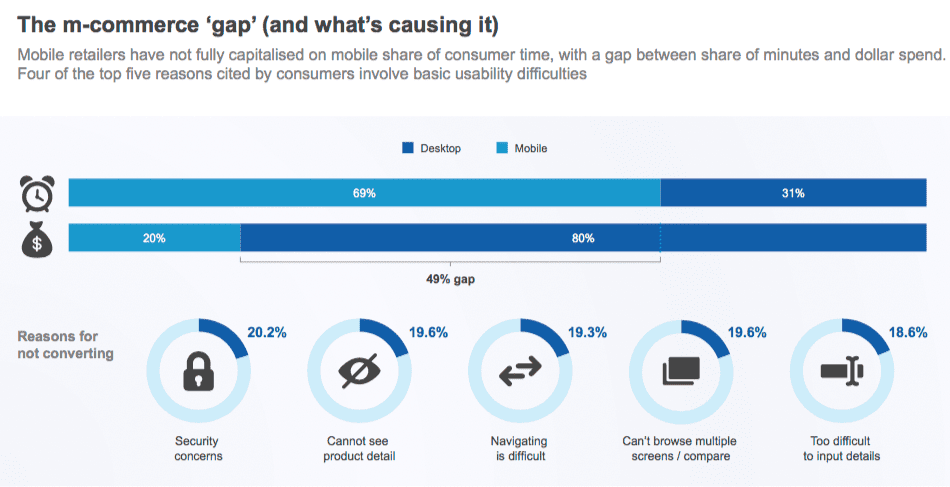
0 Response to "What Is A Good Registered User Conversion Rate For Consumer App"
Post a Comment